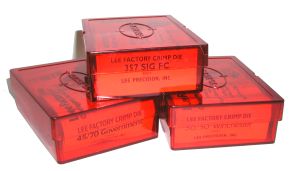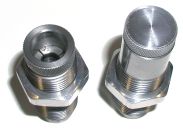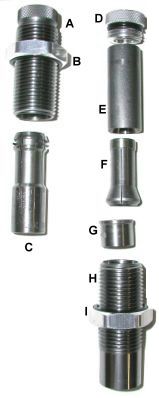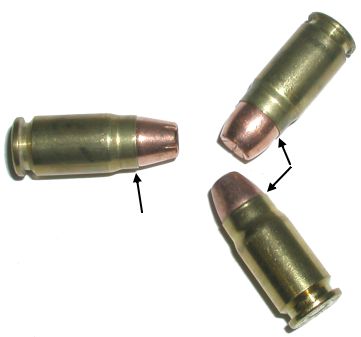
I was a handful of sentences into this story and on my way toward making a wise crack about Lee Precision products, when I realized how hypocritical I’ve been when it comes to that company’s products. I’d gotten into the habit of pigeon holing them as a supplier of cheap equipment; useful for some beginners, not useful for most, and I’ve expressed amazement when I’ve run across an item that performed exceptionally well. We’ll, I own three Lee Factory Crimp Dies, have a fourth on the way, and a cabinet full of Lee Precision casting equipment that performs admirably and reliably, so that obviously isn’t a fair assessment.
Yes, I’ve purchased some Lee products because they were inexpensive, but many more because they were innovative by design and function, and not readily available from other sources. When I was developing high pressure, high velocity 45-70 loads, the Lee Factory Crimp Tool was indispensable. This collet type crimper: held bullets in place, didn’t deformed cases outward to cause cartridge feed problems and the extra hold afforded by the tight crimp bumped initial pressure and delivered slightly higher and much more consistent velocity. In fact, in an earlier article where I was able to objectively assess the holding power of a variety of crimps, the Lee Factory crimp held on the most. Fifty eight pounds of force was required to extract a Lee Factory Crimp Die secured bullet, and the crimp was able to withstand one hundred and twenty two pounds of downward force before the bullet could be dislodged or the case collapsed.
 I always handload 357 SIG ammo to headspace on the shoulder. Nothing controversial here, the practice allows me to size for correct headspace and reliable ignition and requires less brass reforming when sizing more than once fired cases. I believe the weak spot in the SIG case is the narrow .110″ band at the case mouth that grips the bullet. The surface contact is marginal for the job and it limits the selection of bullets to some very specific ogive profiles. Over thinking the 357 SIG….again Part I and Over thinking the 357 SIG….again Part II Furthermore, brass for the cartridge is typically very thin and made from a soft brass alloy. There is too little area to work with for a taper crimp and a traditional roll crimp is too critical in placement, too sensitive to case length variations and too prone to causing case neck distortion and subsequent feed problems. A collet formed crimp, where lateral pressure essentially swaged a neat narrow crimp as the case mouth, seemed ideal.
I always handload 357 SIG ammo to headspace on the shoulder. Nothing controversial here, the practice allows me to size for correct headspace and reliable ignition and requires less brass reforming when sizing more than once fired cases. I believe the weak spot in the SIG case is the narrow .110″ band at the case mouth that grips the bullet. The surface contact is marginal for the job and it limits the selection of bullets to some very specific ogive profiles. Over thinking the 357 SIG….again Part I and Over thinking the 357 SIG….again Part II Furthermore, brass for the cartridge is typically very thin and made from a soft brass alloy. There is too little area to work with for a taper crimp and a traditional roll crimp is too critical in placement, too sensitive to case length variations and too prone to causing case neck distortion and subsequent feed problems. A collet formed crimp, where lateral pressure essentially swaged a neat narrow crimp as the case mouth, seemed ideal.
Just after wrapping up the 45-70 project, I had checked in with Lee, but at the time they didn’t have a version of the die for the 357 SIG. They did offer to make one, at a very reasonable price, if I would provide a case and bullet combination. Unfortunately, I got sidetracked with other projects and never followed through. A couple of weeks ago, after digging around on an Internet retailer’s site, I realized Lee expanded this part of their product line to include some bottle neck pistol cartridges and they were now making a Lee Factory Crimp die for the 357 SIG. The description indicated the die would form a taper crimp, however, a check with Lee Precision verified the die crimps at the case mouth and was, in fact, a Factory Crimp Die. So I purchased one online from Lee, $25.00, and one from Midway USA for $17.99 so I would have two examples for comparison.

Both sources shipped quickly and it was only a few days until I had both assemblies in hand. The die was received packed in the familiar red Lee plastic die box with a slip sheet containing application information as well as the few lines of instructions required to set up the die.
The components are cleanly machined, devoid of errant tool marks, heat treated and highly polished . Both the lock ring and collet cap have an O ring insert to keep them in place during normal operation. The cap is made from aluminum, the balance of the parts are made from steel. The die is standard 7/8″ thread size and works in virtually and metallic reloading press. The greater parts count of the 357 SIG die makes it a little more costly than some others, but none would qualify as expensive.
Factory Crimp Dies and Taper Crimp Dies
 There are a couple of configurations of the Factory Crimp Die; open and closed top. The 45-70 Government and 30-30 WCF, as an example, are open at the top and the case neck passes through the die body. This locates the case mouth centered in the collet jaws and ready for crimping. The 357 SIG is a closed top assembly and has an inverted collet better suited to the case’s stubbiness and shot neck. Only the case mouth enters the collet. In any event, they both accomplish the same task.
There are a couple of configurations of the Factory Crimp Die; open and closed top. The 45-70 Government and 30-30 WCF, as an example, are open at the top and the case neck passes through the die body. This locates the case mouth centered in the collet jaws and ready for crimping. The 357 SIG is a closed top assembly and has an inverted collet better suited to the case’s stubbiness and shot neck. Only the case mouth enters the collet. In any event, they both accomplish the same task.

This may or may not be of consequence to you, but this is the detail of the part differences. The die set on the left is the configuration used for straight wall and center fire cartridges with long neck length. It is a five part assembly; A) die body, B) lock ring with o-ring insert, C) collet with a locating c-clip. All parts are loaded from the bottom.
The SIG crimp die has eight parts; D) collet cap and o-ring, E) crimp closer, F) inverted collet, G) spacer, H) die body, I) lock ring with o-ring insert. The SIG die parts are top loaded, the cap is removed and everything drops out when the die is inverted. The space, G, has a lip that secures the parts from the other end.
Beyond the two type of die configurations noted, there are some other more subtle differences. A factory crimp die for the 375 H&H as an example, is assembled with a long die body. The 45-70 and 30-30 versions get the medium body and the 357 SIG is based on a short body. Prices vary with die configuration and configuration is determined by cartridge type. Factory Crimp Dies are categorized as rifle, pistol and bottle neck pistol. At full retail, rifle cartridge dies run $12.98 for factory crimp, pistol straight wall factory crimp $18.98 for those with carbide a insert, $12.98 without insert. All pistol bottle neck cartridge dies are $25.00.
For the sake of clarity – this is not a combination tool. The Factory Crimp Dies accomplish crimping as a quick discrete step in the handloading process, they do not replace bullet seating dies or other tools. However, I know of no other tool that can deliver these types of crimps.
Simple in Operation

I was going to shoot a series of photos to explain set up and operation, but there aren’t enough steps or enough unique information to make that a worthwhile drill. You insert a standard shell holder in your press, in my case an RCBS shell holder and Rock Chucker press, raise the ram and screw in the Factory Crimp Die until it touches the shell holder, then lower the ram and screw in the die half a turn more for a baseline setting. I eventually increased this to 3/4’s of a turn to get a little more crimp.
The die will ingest virtually every type of ammo. I crimped Winchester, Speer and Remington factory loads, as well as some of my own handloads made from Starline brass. No adjustment was required for any of the above and I could form crimps faster than the speed of priming or decapping. Specifically, these were 125 grain Winchester, Speer and Remington factory loads as well as 147 grain Hornady and 125 grain Gold Dot bullet handloads. The only evidence of the operation is a small recessed ring around the case mouth. The bullets did not have a preformed cannelure, however, the grip was tight enough that the case would collapse before the bullet could be dislodged and driven into the case, and five solid whacks with an inertial puller did not result in a pulled bullet.
As a practical matter….
Generally, my handloading efforts are pretty straightforward and devoid of special tools. I’ve used most of the precision enhanced equipment under controlled conditions, enough to know most is a waste of time for my type of shooting; inaccurate and in high volume. The Lee Factory Crimp Die has been a different sort of investment for me and has resulted in more consistent, more reliable and more accurate handloads. No, the difference isn’t earth shaking, but unlike most theoretical practices, the results are measurable. The pick up in velocity ran from nothing to approximately 18 fps. The slower powder like #9 and True Blue demonstrated the greatest increase. Average deviation within 20 round lots went from 11.2 fps without the crimp to 5.8 fps with the crimp; again with the slower powders showing t he greatest improvement. In addition to these more minor benefits, I’ve had zero feed problems, no bullet case separations under cycling or recoil and I’ve reduced my handloading process time and reduced rejects. Not a bad deal, $17 from Midway USA.
Thanks,
Joe

Email Notification